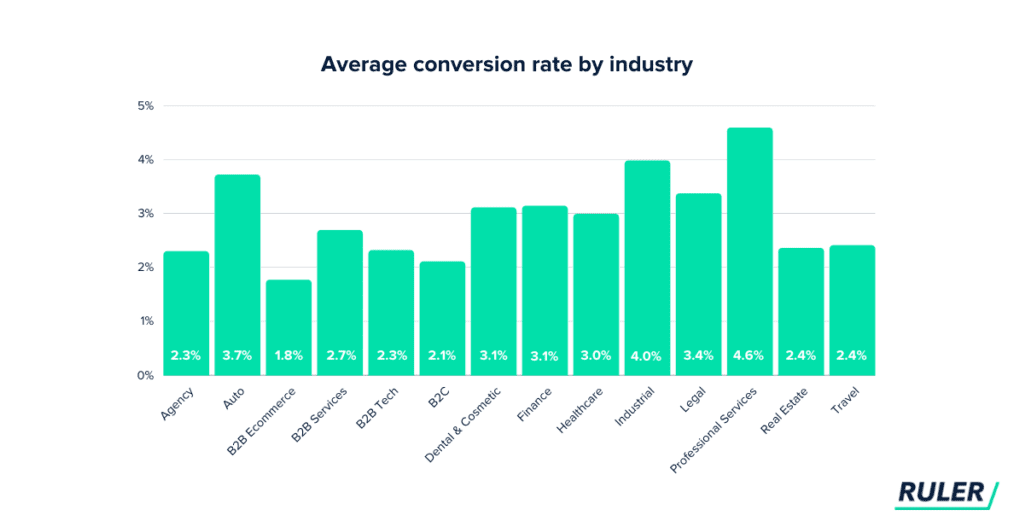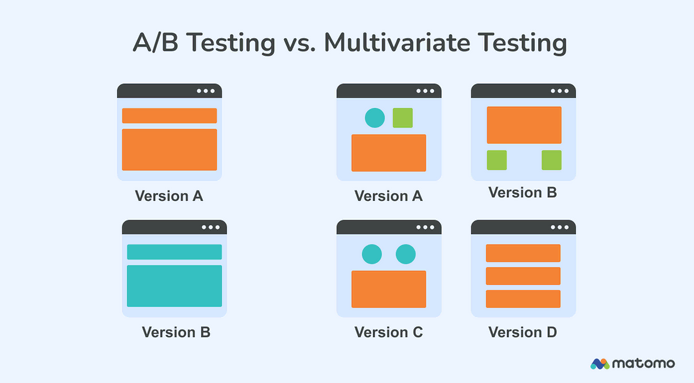Picture this: You spend a fortune driving traffic to your website. With more budget going into your ads and content, you can see the visitor count climb. Then nothing happens.
That is a painful reality for too many businesses today.
Most people who visit your site simply walk away without making a purchase or signing up. Global conversion averages hover around 2% to 3% across most industries. That means 97 out of every 100 people who visit your website leave without generating revenue. This inefficiency is a significant, yet often overlooked, drain on your budget. You bought traffic. Now you must make it pay off.

This image was taken from Ruler Analytics.
Pouring more money into ads does not solve the problem. The smarter move is to make better use of the traffic you already have. That’s what conversion rate optimization (CRO) is all about—it helps you thrive in long-term, ethical, and data-driven growth. CRO is the bridge between wasted clicks and measurable success.
Conversion Rate Optimization 101—CRO Basic Principles
If you are new to the concept, this is a great starting point to learn the principles of this digital marketing optimization strategy.
- What Is Conversion Rate Optimization (CRO)?
Conversion rate optimization is the digital marketing optimization strategy focused on increasing the number of website visitors who complete a specific action, such as a sale, sign-up, or download. It is not about attracting more visitors, but about converting more of the ones you already have.
A “conversion” can be any valuable action. For e-commerce, it is a purchase, while for service businesses, it could be a form submission or a quote request.
CRO combines analytics, psychology, and design to turn interest into action. In digital conversion rate optimization, this approach extends beyond websites to apps and landing pages, aligning user experience with intent. It is not just testing buttons; rather, it is understanding why people say yes or no.

- How Conversion Rate Optimization Works
CRO is a straightforward, ongoing process that uses data to boost your results.
- Research: Gather user behavior data using analytics tools to identify how visitors navigate and interact with your site.
- Hypothesis: Form a high-probability assumption about why visitors are not converting and what could resolve the issue.
- Test: Develop a test that reveals insights into user behavior affecting conversion.
- Analyze: Collect test data and analyze results to identify new patterns and best practices.
- Implement: Apply winning changes.
Types of CRO
Conversion rate optimization can take different forms, depending on the traffic source and business goal. However, the underlying principle remains the same: increasing the percentage of visitors who take a desired action.

- Marketing (or Digital) CRO
Marketing conversion rate optimization and digital CRO are essentially interchangeable. Both describe the systematic process of increasing the number of users who complete a goal—whether that involves making a purchase, signing up, or filling out a form.
- SEO Conversion Rate Optimization
SEO conversion rate optimization, on the other hand, applies CRO principles specifically to organic search traffic. It focuses on what happens after someone finds your site through search engines, ensuring the page they land on matches their intent and encourages them to act.
Businesses investing in SEO AEO AI services Philippines often pair them with marketing CRO strategies to ensure that both visibility and on-site engagement work hand-in-hand for measurable growth.
Key Elements of Effective Conversion Rate Optimization
Successful implementation of CRO tactics requires a deep focus on the user’s experience. You must remove every friction point that prevents a person from completing the desired action.
Below are the fundamental components that play a critical role in successful CRO.
- Landing Page Design and Structure
Design affects trust. In fact, consistent branding can improve conversions by 10-20%. Good landing pages are simple, visually balanced, and distraction-free.
Keep the message clear and use white space to guide the eye. Fast-loading visuals and clear navigation reduce friction. Page load time is critical—improving it can help increase digital marketing conversion rates, as conversions can fall by up to 20% for each second delay on mobile.
- Compelling Calls-to-Action (CTAs)
CTAs are where decisions happen. Replace generic buttons like “Submit” with value-driven phrases such as “Get My Free Demo” or “Start My Trial.” Action-oriented CTAs can substantially boost engagement.
- Form Optimization and Mobile Responsiveness
Shorter forms mean fewer drop-offs. Add autofill and progress indicators to make sign-ups easier. With Google’s mobile-first indexing, a slow or clunky mobile site can harm both your SEO and your conversion rate.
- Social Proof, Testimonials, and Trust Indicators

This image was taken from Wisernotify.
People trust people. Reviews, guarantees, and badges, among other social proofs, reassure visitors. These can remove doubt from the prospect’s mind right before they convert, increasing conversions by up to 34%.
Common CRO Techniques That Actually Work
Once you understand the fundamentals of conversion rate optimization, you can implement specific techniques, such as:
- A/B Testing and Multivariate Testing

This image was taken from Matomo.
A/B testing, also termed as split testing, involves running a controlled experiment where two versions of a webpage element, such as headlines, images, layouts, and CTAs, are compared to determine which performs better in driving conversions. But keep it clean—test one variable at a time to gain accurate insights. If you change two website elements at the same time, you will not know which adjustment caused the improvement.
For more complex pages, multivariate testing allows you to examine several variables at once, but it requires higher traffic volumes to deliver reliable data.
- Heatmaps and User Recordings
To understand user behavior beyond numbers and charts, tools like Hotjar, Crazy Egg, and Lucky Orange provide heatmaps and session recordings. These visualizations show where users click, how far they scroll, and where they get stuck. Such insights reveal usability issues that traditional analytics overlook, enabling you to fix problem areas that hinder conversions.
- Optimizing Page Speed and Navigation
Speed matters. Nearly 47% of users expect a webpage to load within two seconds or less. When pages lag, visitors leave before engaging. This directly cuts into your conversion potential.

This image was taken from Cloudflare.
Improving page load times enhances user experience and positively impacts your site’s SEO performance. Similarly, intuitive navigation helps visitors find what they need quickly, reducing frustration and keeping them on your site longer.
- Personalization and Audience Segmentation
In the modern digital landscape, personalization is no longer optional. Your audience expects content that directly addresses their needs and interests. By segmenting users based on demographics or behaviors, you can tailor messaging to deliver relevant experiences. Personalized interactions can increase engagement rates by more than 20%.
For instance, a company offering PPC marketing services in the Philippines can customize landing pages for different audience segments. This can help the organization increase conversion rates without additional ad spend.
Metrics That Define CRO Success
To measure the effectiveness of your CRO campaign, you need to track the right numbers. Do not rely on vanity metrics; focus on the figures that directly affect your revenue.
- Conversion Rate Formula—Explained
The most fundamental metric is the conversion rate itself. Use this simple formula to calculate it:
Conversion Rate=ConversionsTotal Visitors x 100
For example, if you have 50 sign-ups from 2,000 unique visitors, your calculation is (50 ÷ 2,000) x 100, which equals a 2.5% conversion rate. This number serves as your benchmark. The goal of CRO is to systematically raise that percentage.
- Key Performance Indicators (KPIs) to Track
While the overall conversion rate is important, several supporting KPIs reveal where the bottlenecks are:
- Bounce Rate: The percentage of visitors who leave your site after viewing only one page. A high bounce rate suggests a severe mismatch between visitor expectations and your page content.
- Average Session Duration: Details the average time visitors stay engaged. More time often correlates with a better chance of conversion.
- Click-Through Rate (CTR): The rate at which prospects click on your CTAs or internal links. This measures the effectiveness of your copy and design.
- Revenue Per Visitor (RPV): This is the ultimate health metric. It displays the monetary value of every person who visits your website.
- Other Metrics to Track Long-Term CRO Success
CRO is not a quarterly sprint. It is a long-term discipline. True success is not measured only by one-time conversion spikes.
Sustainable profitability is measured by two crucial metrics: customer lifetime value (CLV) and retention. By focusing on a smooth user experience that converts effectively, you establish a positive customer relationship from the outset. This leads to higher CLV and better customer retention over time.
How to Get Started with Conversion Rate Optimization Today With DMP
Conversion rate optimization is a cycle of constant learning, testing, and improvement. It is not a set-it-and-forget-it solution—and that’s what makes it powerful. Your audience changes, and so, you must consistently test and adjust.
If you want expert support, Digital Marketing Philippines (DMP) can help execute a data-driven strategy built on transparency and long-term impact without relying on inflated ad spending. Our team helps businesses unlock the full potential of their existing traffic through data-driven, ethical strategies designed to boost conversion performance.
Contact us for a personalized consultation today.
References
https://contentsquare.com/guides/conversion-rate-optimization
https://www.taboola.com/marketing-hub/conversion-rate-optimization
https://blog.hubspot.com/marketing/conversion-rate-optimization-guide
https://www.shopify.com/ph/blog/120261189-conversion-rate-optimization
https://www.luckyorange.com/blog/posts/conversion-rate-optimization-guide
https://www.dashly.io/blog/conversion-rate-optimization-cro
https://digitalmarketinginstitute.com/resources/lessons/search-analytics_cro-and-cro-metrics_2G04
https://www.techmagnate.com/blog/conversion-rate-optimization-techniques/
https://www.audioeye.com/post/5-foundational-conversion-optimization-techniques
Jomer B. Gregorio is a well-rounded expert when it comes digital marketing. Jomer is also known as a semantic SEO evangelist and practitioner. Check out our Digital Marketing Services today and let us help you in achieving positive and profitable results for your business.
